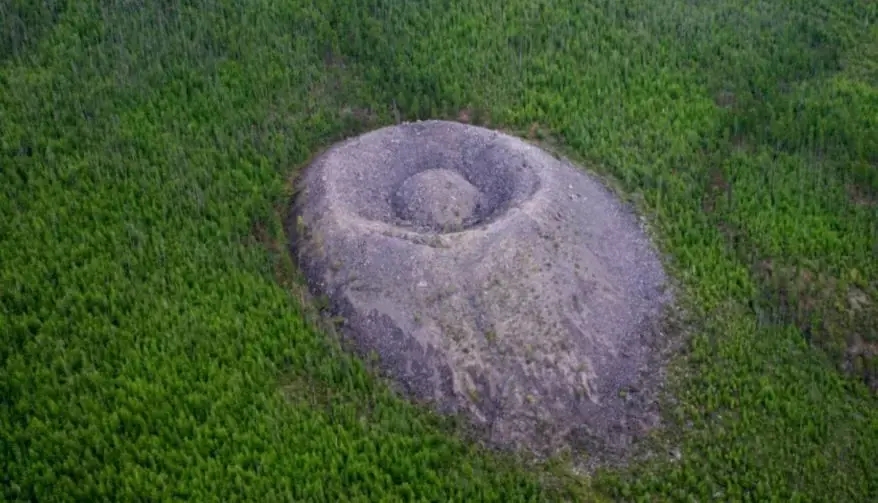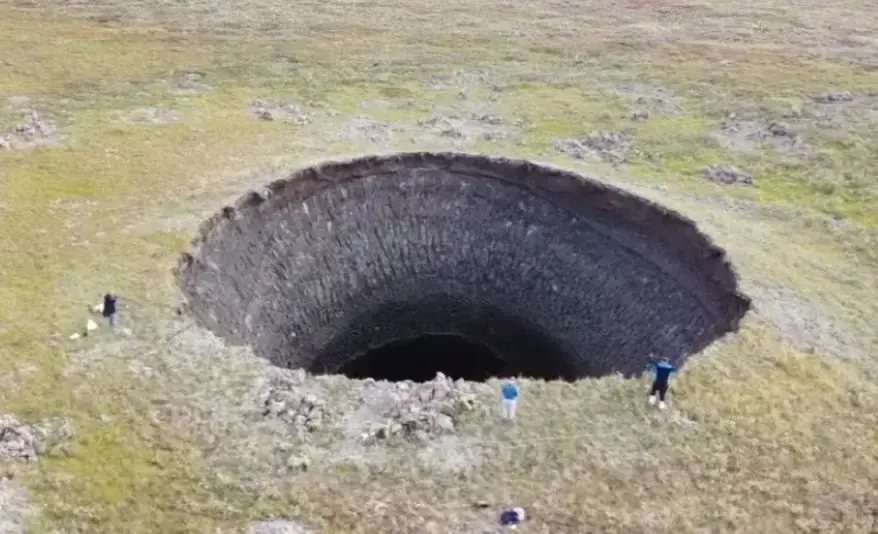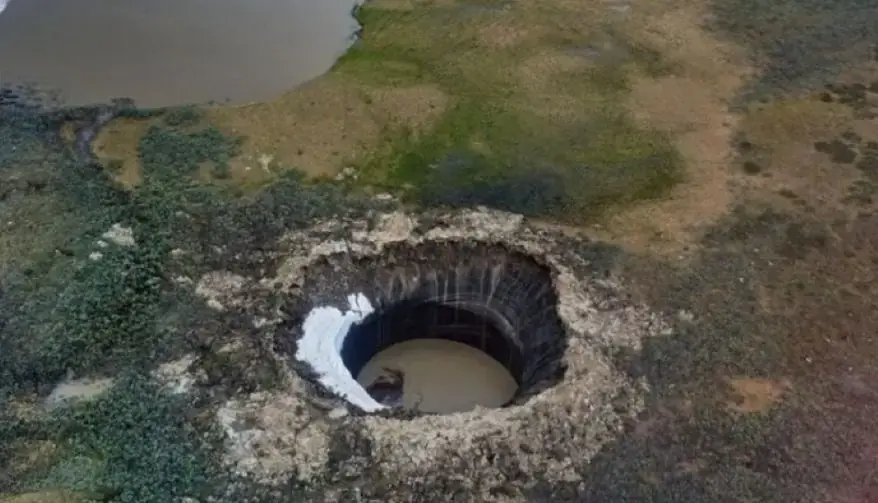The Story Behind the Sudden Appearance of Siberian Craters
You see a crater explode in Siberia. The ground shakes. Gas bursts out. Scientists estimate that between 20 and 30 explosive crater sites now exist. The process starts when warming melts permafrost. Meltwater seeps into salty cryopegs. Furthermore, pressure rises fast. Soil cracks. Methane escapes. Thus, this gas traps heat 25 times better than CO2. Since 2014, at least 17 of these giant escape craters have shocked the world. The story of mysterious Siberian craters shows how climate change triggers dramatic changes in the Arctic.
Sudden Craters in Siberia
First Discovery 2014
The first big discovery was in Siberia back in 2014. People found a huge hole on the Yamal Peninsula. The ground looked like it had exploded from below. Scientists rushed to the site. They wanted to know what caused this strange event. The hole was deep and wide. It shocked everyone who saw it. You could see the frozen earth ripped apart. Thus, this moment started the story of the mysterious Siberian craters.
More Craters Found
After that first discovery, more holes appeared. You can see how the landscape changed. The Yamal Peninsula and nearby areas now show many scars. Here’s what scientists found:
- At first, only three craters were seen on the Yamal Peninsula.
- One new crater sits among more than 20 smaller holes.
- Hence, the land now has dozens of exploded craters.
- Vasily Bogoyavlensky, a top scientist, says many more craters likely exist.
- The huge size of Siberia makes it hard to find every crater.
- At least four craters, named C1 to C4, have been studied in detail.
- Moreover, more than ten surface craters are known, including one from 2010.
- Eventually, some craters turn into lakes after a few years.
- New craters keep appearing, and some locations are still unknown.
You can see that the mysterious Siberian craters are not rare. The number keeps growing as scientists explore more of Siberia.

Satellite Clues
Satellites help you spot new craters from space. They show changes in the ground over time. You can see how some craters form suddenly. Indeed, others grow slowly as the permafrost melts. The largest crater, near Batagay, stands out.
You can see how these craters change the land. The Yamal Peninsula and other parts of Siberia now look very different from above. Satellites give you a clear view of the power of nature at work.
Mysterious Siberian Craters Timeline
2014 Yamal Event
You first heard about the mysterious Siberian craters in July 2014. Reindeer herders spot a huge hole on the Yamal Peninsula. The crater measures about 260 feet wide. News spreads fast. Scientists rush to the site. They want to know what happened. Later that month, you learn about two more craters. Thus, these appear in the Tazovsky district and the Taymyr Peninsula. The story grows. Satellite images soon reveal even more holes. Some craters have clusters of smaller ones nearby. You see that the Yamal and Gydan peninsulas are at the center of this strange event.
In November 2014, a team explored the Yamal crater. They go inside to study its shape and depth. This marks the first close look at one of these giant holes.
Taz District Findings
After the first shock, you notice more craters popping up. The Taz district becomes a hotspot. Scientists use satellites to scan the land. Thus, they found at least seven craters by early 2015. Some craters fill with water and turn into lakes. You see clusters of smaller water-filled holes around the big ones. Russian scientist Vasily Bogoyavlensky compares the spread to mushrooms after rain. He says many more craters likely exist. The Yamal and Gydan peninsulas now show dozens of scars. The number keeps growing. Indeed, you realize that the mysterious Siberian craters are not rare. Therefore, they keep appearing as the ground warms.
2015 and Beyond
The story does not stop in 2015. You watch as new craters appear every year. The Yamal and Gydan peninsulas remain the main sites. However, the phenomenon spreads to nearby regions. Scientists link the increase to rising Arctic temperatures. In 2020, the Arctic hit a record 100.4°F in Verkhoyansk. Thus, this heat melts the permafrost. Methane gas builds up under the ground. When pressure gets too high, the Earth explodes. You see more mysterious Siberian crater forms. By 2024, researchers explain that warming, osmosis, and unique geology all play a role. The Yamal and Gydan peninsulas stay in the spotlight. Experts warn that climate change will make these events more common. Moreover, you see urgent calls for more research and safety checks.
Causes of Mysterious Craters
Methane Gas Explosions
You see the ground split open. The force comes from explosive belches of gas. Methane builds up under the frozen earth. When pressure rises, the ground bursts. Hence, you notice powerful gas blowouts. These blasts throw ice, mud, and water high into the air. Scientists call this cryovolcanism. Certainly, it is not lava, but a mix of gas, ice, and soil.
- Methane gas deposits form from both deep rocks and microbes.
- The crater rim shows carbon ratios from biogenic and thermogenic methane.
- Certainly, the crater forms quickly, sometimes in just one year.
- Underlake taliks trap gases under freezing layers.
- Drone surveys and soil samples help scientists study these explosions and, resulting craters.
- Warming Arctic air melts icy caps, making explosions more common.
You see that methane and carbon dioxide get trapped under the permafrost. Freezing and thawing cycles push gases into pockets. When the pressure gets too high, you get an explosive release of gas. This process releases additional greenhouse gases into the air. Hence, climate warming makes these events happen more often.
Thawing Permafrost
You notice the ground changing. Permafrost holds ancient organic matter and methane. When it thaws, microbes wake up. They break down the organic material. Thus, this makes methane, especially in wet, low-oxygen spots. Thawed permafrost slumps and collapses. Hence, you see craters and sinkholes appear.
- Permafrost stores twice as much carbon as the air.
- Thawing makes the ground slump and form ponds.
- Microbes in wet soil make methane.
- You see bubbles of methane escape from thawed ground.
- Abrupt thaw exposes deep layers, releasing methane and carbon dioxide.
- Thus, these changes happen faster than scientists expected.
Satellite images show sudden changes in the land. Methane craters form when permafrost thaws quickly. Water fills the craters, making lakes. These lakes speed up thawing and methane release. Outgassing from these craters is only a small part of the total methane from thawing permafrost. Further, rapid warming in the Arctic makes these changes happen even faster.
Early Theories
You may hear wild ideas about these craters. Some people thought missiles or meteorites made them. Others blamed UFOs. Scientists found high methane near the craters. Therefore, this proved the cause was inside the Earth, not from space.
- One theory says cryopegs, salty water under permafrost, swell and crack the ground.
- Modeling shows that osmosis-driven water movement can build pressure.
- Some think methane comes from deep rocks linked to oil and gas.
- Ice layers may block water movement, making the process complex.
- Methane hydrates can release gas suddenly, not just slowly.
The Tunguska event is different. It was a meteoroid airburst, not a crater-forming explosion. Trees flattened in a radial pattern. Indeed, no crater formed. Thus, this shows cosmic impacts differ from methane-driven explosions and resulting craters in Siberia.
Mystery of the Siberian Craters
Tree Ring Analysis
You can learn a lot from trees. Scientists use tree ring analysis to study changes in the Siberian landscape. Each ring tells a story about the climate and soil. When a crater forms, it can damage or kill nearby trees. Moreover, you might see missing rings or scars in the wood. These marks help you figure out when the ground exploded. Dendrochronology shows that some craters formed in the last few decades. Other trees show signs of stress from sudden ground movement. Therefore, this method gives you a timeline for crater events. It also helps you see how the land changed over time.
Geospatial Studies
You can spot craters from space. Scientists use many tools to map and study these features. Here are some of the main techniques:
- High-resolution satellite images, like WorldView stereo pairs
- Remote sensing data from satellites
- UAVs (drones) for close-up aerial surveys
- Ground-based tools such as echo sounders and ground-penetrating radar
- GIS software, including ArcGIS, for mapping
- InSAR radar data for tracking ground movement
- Digital Elevation Models (like ArcticDEM) for 3D terrain views
- Also, volunteers who check satellite images for new craters
- Big data systems to handle huge Arctic datasets
Researchers work with a massive 7-terabyte elevation dataset from WorldView satellites. This data lets you see the land in great detail. You can spot new craters and track changes over time. Volunteers help by checking satellite photos for hotspots. Thus, this teamwork makes it possible to monitor the vast Siberian tundra. Hence, you get a clearer picture of how and where craters form.
Climate Impact
Methane Release
You see the ground burst open. Methane escapes fast from these craters. This methane release comes from deep under the permafrost. Furthermore, when the ground warms, pressure builds. The Earth explodes, sending methane into the air. Each crater may seem small, but the permafrost holds more carbon than the whole atmosphere. That means methane release from permafrost can speed up climate change.
- Firstly, methane trapped in Siberian permafrost escapes through blowout craters.
- Each explosion releases thousands of cubic meters of methane.
- Methane release adds to carbon dioxide from wildfires.
- The more craters you see, the more methane enters the air.
- No easy fix exists. Stopping fossil fuel use is the best way to slow permafrost thaw.
Methane release from these craters, plus wildfires, makes global warming worse.
Feedback Loops
When permafrost thaws, it sets off a chain reaction. Additionally, you get more methane release. Hence, this gas traps heat in the air. The world gets warmer. Warmer air melts more permafrost. This is a feedback loop. The process keeps going, making climate change even faster.
Wildfires burn away the top layer of soil. Thus, this exposes deeper permafrost to heat. Snow and ice melt, leaving dark soil. Dark soil absorbs more sunlight. Also, the ground warms up. Plants grow on the new soil, making it even darker. Additionally, all these changes speed up permafrost degradation and methane release. Scientists say these feedback loops could make climate change much harder to stop.
Local Effects
You notice big changes in the Siberian tundra. Craters appear overnight. The ground collapses, forming pits and lakes. Landslides and tunnels change the landscape. Therefore, these events come from permafrost melting and pressure from salty water layers below.
When a crater forms, high levels of methane escape. The sudden methane release changes the air and the land. Local plants and animals lose their homes. Further, the ground becomes unstable. New lakes form where the earth fell in. Thus, these lakes can release even more methane as they warm up.
Scientists see thousands of small gas pockets under the tundra. Some make bubbling lakes. Others explode, making new craters. Hence, these changes disrupt the ecosystem. They also add more methane to the air, making human-caused climate change worse.
The effects of melting permafrost reach far beyond Siberia. You see the impact in rising temperatures around the world.

Ongoing Research
Monitoring Efforts
You see scientists watching Siberian craters closely. They use many new tools to track changes. Satellites play a big role. You get data from Landsat and Sentinel-2A. These satellites show how craters grow and how plants change inside them. Certainly, you notice scientists use NDVI to check vegetation health. Thus, they also watch land surface temperature with thermal bands. Digital elevation models help measure crater depth and shape. The ASTER GDEM-2 model gives clear views of the land. These tools let you see changes over almost thirty years.
Therefore, they also help predict where the next explosion might happen. You get a better idea of how methane escapes as the ground warms.
New Discoveries
Scientists found two new craters close to the Bovanenkovo-Ukhta pipeline and the Obskaya-Bovanenkovo railway. Moreover, you see that gas pressure builds up under the ground. Further, it pushes up mounds called pingos. When the pressure gets too high, the ground explodes. This makes a crater and releases methane.
You notice most craters form in the Yamal and Gydan peninsulas. Thus, these areas have thick permafrost and lots of natural gas. Warming makes the ground unstable. Certainly, you see more methane released as the land changes. Satellite images show new lakes and streams forming. These changes mean more risk and more surprises.
Conclusion
You now know why Siberian craters appear so suddenly.
- Mostly, gas builds up under permafrost and explodes, forming these craters.
- Secondly, thawing permafrost and warming temperatures speed up this process.
- Thirdly, methane and carbon dioxide escape, which are linked directly to climate change.
References
- Froitzheim, N., Majka, J., & Zastrozhnov, D. (2021). Methane release from carbonate rock formations in the Siberian permafrost area during and after the 2020 heat wave. Proceedings of the National Academy of Sciences, 118(32). https://doi.org/10.1073/pnas.2107632118
- Anisimov, O., & Zimov, S. (2020). Thawing permafrost and methane emission in Siberia: Synthesis of observations, reanalysis, and predictive modeling. AMBIO, 50(11), 2050–2059. https://doi.org/10.1007/s13280-020-01392-y
- Chuvilin, E. M., Sokolova, N. S., Bukhanov, B. A., Davletshina, D. A., & Spasennykh, M. Y. (2021). Formation of Gas-Emission craters in northern West Siberia: Shallow controls. Geosciences, 11(9), 393. https://doi.org/10.3390/geosciences11090393
Additionally, to stay updated with the latest developments in STEM research, visit ENTECH Online. Basically, this is our digital magazine for science, technology, engineering, and mathematics. Furthermore, at ENTECH Online, you’ll find a wealth of information.






